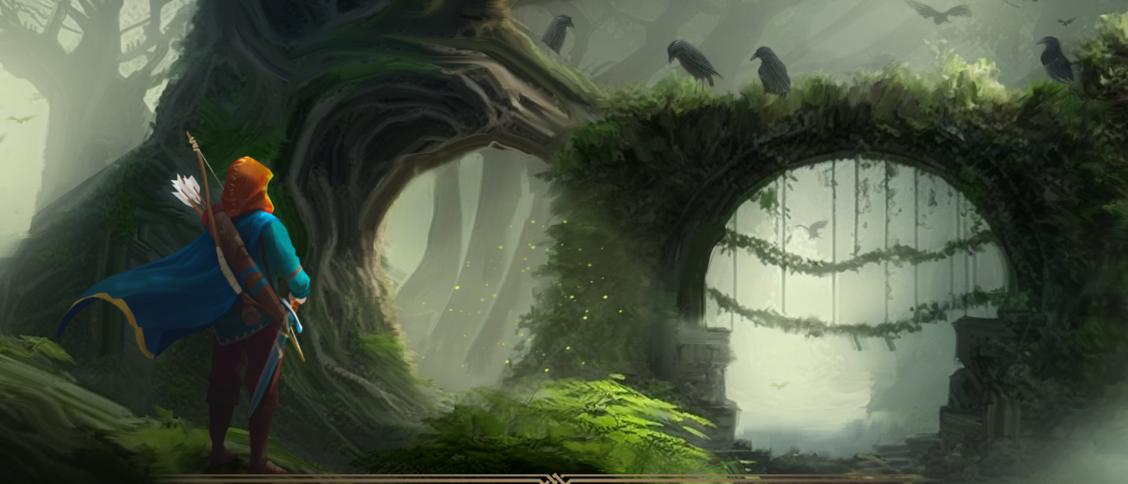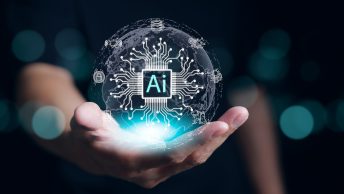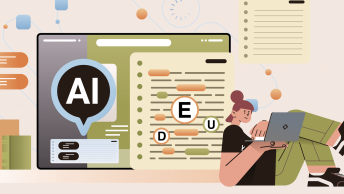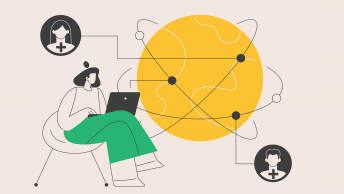Before we go deeper into this subject, let me add personal info about myself. Not because I’d like to brag but rather to highlight the fact that I’ve been working in the creative field basically my entire life. I started to work as a graphic artist, then art director, creative director, then together with friends we opened a creative production studio. Finally, I landed in the area I love the most – game development industry. Games are the whole package where you need to tell the story using all audiovisual components and the most important one – gameplay.
So, I’m writing this article from the creative person’s perspective. My entire life, I spent with the vision to create innovative things, amaze people and give them joy. And.. as many of you probably – I didn’t expect the change to happen in the last several months. We will get back to my feelings and thoughts on the topic of AI and art in the conclusions. Let’s start by introducing the topic.
The gaming industry has always been at the forefront of innovation, constantly pushing the boundaries of what is possible. From the earliest video games to the latest virtual reality experiences, game developers have always been looking for ways to improve the player experience and… amaze players. I remember when I saw my first game on the Arcade machines, I was blown away that TV allows me to interact with the content. From that very moment, I knew I wanted to create games. No matter in which form – on paper, electronic, puzzles, you name it. My life goal was to give the joy for the people and intrigue, spark curiosity and for the moment they play my game – be transported to another world.
The process of creating games is time-consuming and because it consists of so many audiovisual aspects, we need time to create such a product. The less tangible is the gameplay, which is a whole story for another article, but basically, it’s how the game plays and what emotions convey.
So no wonder when AI algorithms were introduced, everyone looked in that direction, thinking – we need this to finish our game faster, be competitive on the market and automate tedious work like simple asset creation. We have tested a lot of AI tools and at the end Midjourney seems to be the way to help us. In our newest game: Hero Legacy – RPG Adventure. we have a ton of illustrated content and we decided to get support from Midjourney to create them.
As a result we not only created them faster, but our imagination was positively fueled by output from Midjourney. What we also noticed is that we can’t use it 1:1. We need to reengineer our process to get the best results.
Reengineering the creative process
It was evident to us that by using AI we can iterate faster, find references quicker and, in the end, improve the process of asset creation. It does not mean at any point it’s less creative. It’s different but by any means “worse or less creative”. In fact, as I stated above – very often we had this thought – why we haven’t thought in this direction? But to fully take advantage of it, we need to change the way we work.
The previous art creation process we had consisted of stages:
1. Creative briefing,
2. mood-boards,
3. sketches,
4. the first colour overpaint,
5. details and finished illustration.
The new process looks like this:
1. Creative briefing,
2. AI content from Midjourney,
3. composition defining and blocking,
4. overpaint.
5. details and finished illustration
Even if there is the same number of steps, we speed up more than twice implementing this in our pipeline. Example of creating one of the illustrations:
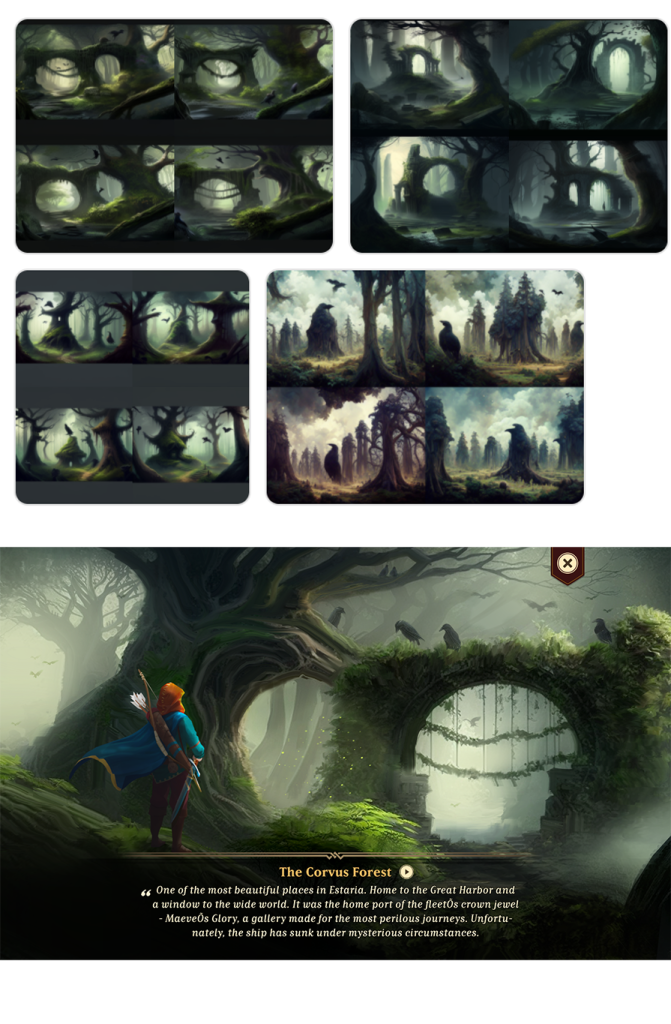
What we have also noticed during the process is that AI very often gave us results very much in line with our imagination and expectations. This led to the next point:
AI vs human – referencing
There is a growing concern that AI-generated content may lack the creativity and diversity of human-generated content. Some critics argue that AI can only generate content similar to what it has been trained on, and since much of the data used to train AI comes from the internet and pop culture, the output may not be original or innovative.
It is true that AI learns from the references it is fed, but these references often come from the same sources that influence human creativity. The internet is a vast repository of images, videos, and other media that are created by humans, and much of this content is derivative of earlier works. Pop culture, which includes movies, television shows, music, and other forms of entertainment, is also heavily influenced by earlier works and often relies on familiar tropes and archetypes. However, it is essential to note that the output of AI-driven tools is not necessarily predetermined by the data it is trained on. AI tools like Midjourney use complex algorithms to analyze and classify data, and they can identify patterns and similarities that humans may not see.
This means that AI-generated content can be surprising and innovative, even if it is influenced by earlier works.
It is also worth adding that humans are constantly influenced by the content they consume. We are all products of our culture, and the art and media we create are inevitably influenced by the works that have come before us. This is not necessarily a bad thing; in fact, it is often through the process of imitation and adaptation that we develop new ideas and push creative boundaries. Of course, perception of this fact depends on cultural inclination, but most Asian cultures are building on that fact. Step by step, build on the work that has been created. In the worst case scenario you have the same result, better scenario – you will add something and create new value and in a very small percentage – there is a chance to discover or rediscover.
Conclusions:
I was wondering in what form I should formulate my thoughts on using AI in the creative process, and I came up with the idea to interview myself from both sides: the artists and a writer trying to glimpse a bit more into the future:
What was the result of using AI tools in creative process?
We have achieved comparable the same result faster so at the end we are able to expand the content within the game twice in the same time.
What do you think of using AI in the commercial creative process?
AI is nothing more than a tool. If you think of it as a threat to human creativity and our jobs – it’s probably will be difficult to change your mind. But please consider the fact that many inventions in our history of development were called a threat to human creativity (or existence), and I think AI is no different. What is most important – it’s inevitable since it gives a commercial advantage in the process of creation. So this is not a question about if only about how you use it. Don’t treat it as a giveaway solution, be creative and find your own way to use it in your creative process.
Will AI take the jobs of the artists?
No matter how harsh it sounds – it will take many of the jobs in the creative are. Most of automated processes will be replaced. But I believe humans still need to pilot where we want to go and what we want to achieve. At least at this stage of development. The time we are now will be a massive change for the art market. Stocks have become obsolete; in the upcoming months, we will see a global shift from skill (ability to make specific art) into creativity, imagination and being able to adapt to the change. Times when you needed to have certain skills to create an art are in the past. The real value is in the creative briefing and clearly understanding the goal you want to achieve.
How do you feel about this change?
It’s a weird mixture of excitement and feeling uneasy. We are definitely moving in a direction in which is hard to predict and define how it will influence us in the future. Creativity was always an area where humans dominated, and the simple thought that we are giving away all our knowledge and findings is not easy to accept. On the other hand as I stated above – it’s inevitable. It will come since it gives an advantage.
As always future will tell. Thanks for reading.

